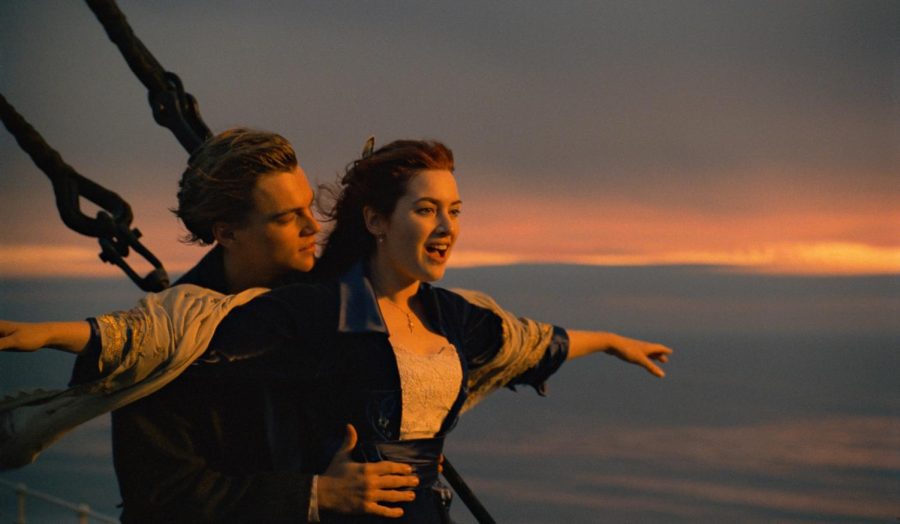In 25th Anniversary 3-D Theatrical Re-Release, ‘Titanic’ Is Just As Epic As Ever
Paramount Pictures
Leonardo DiCaprio (left) and Kate Winslet starred in Titanic (1997) as ill-fated lovers. The film recently returned to theaters in remastered 3-D.
February 13, 2023
The 1990s were the ultimate era of disaster epics, but only a handful have stood the test of time. The best of them all: Titanic, a three-hour love story centered around the 1912 sinking of the trans-Atlantic luxury steamship.
From the moment it hit theaters in 1997, Titanic was a hit. Until the release of Avatar in 2009, it held the box office revenue record with $2.2 billion, and it is tied for the most Oscars of all time for a single film – 11, including Best Picture and Best Director.
Titanic is widely considered the best disaster movie ever made. Aside from the accolades, it’s also fairly historically accurate. Between survivors’ accounts and research into how the ship would’ve actually sunk, James Cameron created a story that almost entirely followed the true course events (although, of course, some things are dramatized, and main characters Jack and Rose weren’t real).
Historical figures such as Titanic’s captain E.J. Smith (Bernard Hill), designer Thomas Andrews (Victor Garber) and owner J. Bruce Ismay (Jonathan Hyde) appear, as well as Coloradan survivor Molly Brown (Kathy Bates), wealthiest man on the ship John Jacob Astor IV (Eric Braeden), and several other ship officers and famous passengers. Most receive storylines true to witness accounts. Many lines exchanged between ship officers after Titanic hits the iceberg and begins to sink are also true to accounts and the ship’s log, according to Titanic: An Illustrated History by Don Lynch.
But even if you don’t know any of that, watching Titanic is an experience epic enough to live up to the tale. And it’s even better in the theaters, where it has temporarily returned in 3-D for the film’s 25th anniversary.
Despite my love for Twister (1996), Dante’s Peak (1997), and other similar disaster movies from the same time period, I had never seen Titanic. But the theatrical experience of the film was an exquisite way to be introduced to it.
The whole film hinges on an impending sense of doom. The story begins in 1996, with exploration of Titanic’s wreckage, before traveling back in time to 1912 – so, by the time you see the ship’s majestical interior during its maiden voyage, you’ve already seen what those same places look like at the bottom of the ocean 84 years later. When you get attached to Rose Dewitt Bukater (Kate Winslet) and Jack Dawson (Leonardo DiCaprio) at the very beginning of the movie, you know they’re headed to potential death (whether or not you’ve heard the debate over the door). And when you see the joy and hope of Titanic’s passengers as they depart on April 10, 1912, you know you’re going to watch the majority of them die less than five days later.
And as you follow life on the ship, that doom grows: Rose’s conflicted relationship with both her mother and fiancé leads her to contemplate suicide, while conversations between the ship’s captain, designer, and line manager hint at icebergs in the ship’s path, overexerting the ship’s new engines, and potential design flaws in the supposedly unsinkable Titanic.
Yet, somehow, you’re still enveloped in the good parts of the story. For the first half of the movie, Jack and Rose’s blossoming relationship, despite social pressures from all sides, is the focus. Jack’s relentless optimism and artistry despite being poor and orphaned make him the ultimate lovable boy, while Rose’s desire to escape her first-class upbringing and willingness to step outside her bubble makes her a brave and endearing protagonist. As they find each other, fight for each other, and later strive to live and die for each other, you’re caught up in the human side of the iconic history. And as muddled of a plot this sprawling movie could’ve had, every possible piece of the story receives closure at the end. The fate of every single character you meet is shown.
Titanic made headlines twice in 1912 – once as an unsinkable luxury liner, the largest of its class, and again when it struck an iceberg and sank, killing around 1,517, the majority of whom were men, crewmembers, and lower class passengers. From the day it happened, the wreck captivated headlines across the globe and led court cases and government inquiries. Over the following decades, however, it became something of an American myth. Until the ruins of the ship were finally discovered in the Atlantic Ocean in 1985, little was known about how it actually sank. Since then, multiple expeditions have shed more light on the event and recovered artifacts from the wreckage.
But the 1997 film Titanic allowed many to grasp the sheer enormity and humanity of what had happened. As the ship sinks in the film, and as we follow Jack and Rose between decks and halls and lifeboats in an attempt to survive, we are surrounded by the creaks and groans of a dying ship. When it finally sinks fully below the water, the screams and whistles of floating survivors are all we can hear – until, not long after, it’s silent. In the theater, all of this is augmented. You understand why Titanic won its Oscars for sound design and special effects.
Titanic’s return to theaters is the perfect opportunity to experience the epic film in its original glory. It is the opportunity to see the stories of so many people who died and survived the well-known disaster. So if you can, find a showtime this week to see Titanic on the big screen.






















